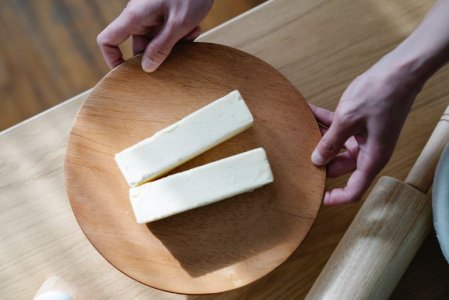Should you really be eating off a butter board? Experts weigh in
- Replies 16
These days, it seems like there's a new food trend every week. Some of them are pretty…out there, while others don’t seem so bad.
One food trend that seems to be making waves is the butter board. For those who don’t know (like some of us here at SDC, we must confess), butter boards are sort of like a charcuterie board…but with butter as the main ingredient.
As more and more people jump on the butter board bandwagon, nutrition experts are warning that the food trend comes with some serious health risks.
People, especially the younger generation, have a habit of jumping into trends they see on social media – sometimes without noticing that these viral ‘hacks’ can be dangerous to their health.
Butter boards are no different. They might look appetising at first, but health experts beg to disagree.
Butter boards first started appearing on TikTok thanks to food content creator Justine Doiron. She’s credited with coining the term back in September, citing that she got the inspiration from Chef Joshua McFadden’s cookbook.
Since then, the butter board trend has taken over almost all popular social media platforms.
You can watch Justine’s video here:
However, not everyone is a fan of this new creation.
Laura Cipullo, a Registered Dietician based in New York City, wants this specific food trend to just ‘go away’.
‘The idea of smearing something on a wood board with other food, sharing that with other people and having them all dip into it – it’s a bacteria heaven,’ she said.
A study proved how easily bacteria, such as E. coli, can stay and multiply in wooden cutting boards. You can read more on that here.
So, maybe it’s best to stay away from the butter boards from now on.
The study was supported by Food Industry Regulation Expert Darin Detwiler, who said that ‘pathogens are everywhere’ in butter boards.
This is in part because wooden boards crack, and those cracks are very difficult to clean.
Mr Detwiler, who is an Assistant Teaching Professor at Northeastern University, entered the food policy field after losing his 16-month-old son in the 1993 E. coli outbreak tied to contaminated beef at Jack in The Box restaurants.
‘Personally, I would use a plastic board. Something that can be sanitised in a dishwasher,’ he suggested.
He added: ‘The second hidden danger is the idea of so many hands on a butter board. People think big. People don’t think about doing small butter boards.’ Mr Detwiler said that when it comes to making this trend, people are all about ‘big, beautiful displays’.
He stated that if any of those hands aren’t washed, there’s a bigger chance for bacteria to spread quickly.
Paul Zahn, a Los Angeles-based Entertaining Expert offered a compromise: the ‘jarcuterie’.
‘Make individual jars or boards for guests, that way people keep their germs to themselves and you’re giving them portion control,’ he shared.

What do you have to say about this, folks? Let us know in the comments section! As always, please do proper research and consult with your GP before trying out any of the viral food trends you see on social media!
One food trend that seems to be making waves is the butter board. For those who don’t know (like some of us here at SDC, we must confess), butter boards are sort of like a charcuterie board…but with butter as the main ingredient.
As more and more people jump on the butter board bandwagon, nutrition experts are warning that the food trend comes with some serious health risks.
People, especially the younger generation, have a habit of jumping into trends they see on social media – sometimes without noticing that these viral ‘hacks’ can be dangerous to their health.
Butter boards are no different. They might look appetising at first, but health experts beg to disagree.
Butter boards first started appearing on TikTok thanks to food content creator Justine Doiron. She’s credited with coining the term back in September, citing that she got the inspiration from Chef Joshua McFadden’s cookbook.
Since then, the butter board trend has taken over almost all popular social media platforms.
You can watch Justine’s video here:
However, not everyone is a fan of this new creation.
Laura Cipullo, a Registered Dietician based in New York City, wants this specific food trend to just ‘go away’.
‘The idea of smearing something on a wood board with other food, sharing that with other people and having them all dip into it – it’s a bacteria heaven,’ she said.
A study proved how easily bacteria, such as E. coli, can stay and multiply in wooden cutting boards. You can read more on that here.
So, maybe it’s best to stay away from the butter boards from now on.
The study was supported by Food Industry Regulation Expert Darin Detwiler, who said that ‘pathogens are everywhere’ in butter boards.
This is in part because wooden boards crack, and those cracks are very difficult to clean.
Mr Detwiler, who is an Assistant Teaching Professor at Northeastern University, entered the food policy field after losing his 16-month-old son in the 1993 E. coli outbreak tied to contaminated beef at Jack in The Box restaurants.
‘Personally, I would use a plastic board. Something that can be sanitised in a dishwasher,’ he suggested.
He added: ‘The second hidden danger is the idea of so many hands on a butter board. People think big. People don’t think about doing small butter boards.’ Mr Detwiler said that when it comes to making this trend, people are all about ‘big, beautiful displays’.
He stated that if any of those hands aren’t washed, there’s a bigger chance for bacteria to spread quickly.
Paul Zahn, a Los Angeles-based Entertaining Expert offered a compromise: the ‘jarcuterie’.
‘Make individual jars or boards for guests, that way people keep their germs to themselves and you’re giving them portion control,’ he shared.
Key Takeaways
- Butter boards are a popular food trend, but health and nutrition experts aren’t fans of this viral dish.
- Butter boards are being criticised for being unhygienic and potentially dangerous, as they can host bacteria and cause others to get sick.
- Some experts suggest using other, less risky boards (such as plastic) as an alternative to wooden boards.









